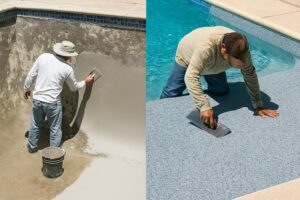Table of Contents
ToggleUnderstanding Pool Replastering
Pool replastering is a method of completely replacing the worn-out plaster surface of your swimming pool. Over time, the existing plaster gets a rough textures, rust stains, or structural cracks. When these signs appear, replastering becomes essential to maintain your pool’s attractiveness, safety, and longevity.Process Overview
The pool replastering process typically involves these clear, easy-to-follow steps:- Inspection and Draining the Pool: Professionals use a submersible pump to safely drain all pool water. They carefully check the surface condition, noting areas that need special attention.
- Surface Preparation (Removal of Old Plaster): They remove the existing plaster surface using specialized tools, ensuring the surface is properly prepared and debris-free.
- Application of New Plaster: Experts apply a bonding agent (bond coat) and carefully spread two coats of fresh plaster, usually made of white cement mixed with fine aggregates, creating a smooth finish.
- Refilling and Chemical Balancing: After the plaster cures, they refill your pool, adjust the chemicals, such as chlorine, and closely monitor the water chemistry for the first seven days to ensure safety.
Pros and Cons of Pool Replastering
| Pros | Cons |
| Restores smoothness and aesthetics | Higher upfront cost |
| Fixes structural surface issues | Longer downtime for the pool |
| Significantly extends your pool’s life span | More labor-intensive process |
Understanding Pool Resurfacing
Pool resurfacing means adding a durable, attractive new surface over your pool’s existing finish. Unlike pool replastering, resurfacing involves applying materials such as pebble, quartz, or aggregate. This covers minor cracks, rough spots, and calcium deposits, making your pool look new while providing protection against algae and stains.Step-by-Step Pool Resurfacing Process
The pool resurfacing process typically includes four clear steps:- Assessment and Draining: Professionals carefully examine your pool’s current condition, then drain the water safely.
- Surface Preparation (Cleaning, Minor Repairs): Next, they clean the existing surface, fix small damages, and use an acid wash to ensure proper adhesion. According to Angi, this important step helps remove cracks and rough spots, preventing injuries like cut feet and stopping water loss.
- Applying the Resurfacing Material: The experts evenly apply your selected finish—often pebble, quartz, or aggregate—resulting in a smoother, more appealing surface.
- Curing, Refilling, and Chemical Balancing: After applying the new material, it cures for several days (times vary depending on the material). Once cured, they refill your pool, carefully balancing chemicals to ensure safe swimming.
Benefits and Downsides of Pool Resurfacing
| Pros | Cons |
| Enhanced durability and attractive look | Cost varies widely depending on selected materials |
| Reduced algae growth and stain resistance | Requires skilled professionals for correct results |
| Lower maintenance needs over the long term | Can involve longer curing periods |
Signs Your Pool Needs Replastering
As your pool plaster ages, clear signs will indicate that it’s time to replaster the pool. You may first notice issues while swimming, such as roughness or discomfort in your feet. These symptoms typically indicate your plaster is worn. Watch out for these specific signs your pool plaster needs attention:- Cracks, flaking, or rough texture: Small cracks or rough areas aren’t just unpleasant—they can become larger issues and cause leaks over time.
- Stubborn stains and discoloration: If persistent stains remain even after balancing the chemicals, deeper damage is likely to present within the plaster itself.
- Visible thinning or peeling plaster: Thin or peeling plaster clearly signals that your pool plaster is compromised, making replastering essential to prevent further deterioration.
Signs Your Pool Needs Resurfacing
Pool resurfacing becomes necessary when problems occur repeatedly, no matter how often you treat your pool. Ongoing water loss is one major sign. You may notice you’re constantly refilling your pool to maintain the right water level. Key indicators that it’s time for resurfacing your pool include:- Recurring leaks or water loss: Frequent or unexplained water loss suggests cracks or damaged areas beneath the surface, which resurfacing can fix effectively.
- Difficulty controlling algae growth: Older pool surfaces with tiny cracks and pores create ideal hiding spots for algae, making treatment difficult and ineffective.
- Dated appearance affecting pool enjoyment: An outdated or worn appearance can significantly reduce the pleasure of using your pool. Resurfacing restores its inviting look, making your pool enjoyable again.
Professional Pool Evaluations: Why It Matters
 A professional evaluation is essential when deciding to resurface or replaster a pool. Without expert insights, you might choose the wrong solution, wasting money and effort. Skilled pool contractors accurately pinpoint issues, from damaged plaster surfaces to critical steps in the curing process. By receiving clear, customized recommendations, you confidently choose the best repair method for your pool.
Professional Aquatic Services, a trusted pool contractor in Florida, can precisely assess your pool’s condition and suggest effective, lasting solutions. Choosing a professional evaluation helps you avoid unnecessary costs, extends your pool’s life, and ensures you fully enjoy your pool again.
A professional evaluation is essential when deciding to resurface or replaster a pool. Without expert insights, you might choose the wrong solution, wasting money and effort. Skilled pool contractors accurately pinpoint issues, from damaged plaster surfaces to critical steps in the curing process. By receiving clear, customized recommendations, you confidently choose the best repair method for your pool.
Professional Aquatic Services, a trusted pool contractor in Florida, can precisely assess your pool’s condition and suggest effective, lasting solutions. Choosing a professional evaluation helps you avoid unnecessary costs, extends your pool’s life, and ensures you fully enjoy your pool again.
Frequently Asked Questions
Pool replastering completely replaces the worn plaster surface, which is ideal for severe damage. Pool resurfacing adds a new, durable layer, such as pebble or quartz, to address minor issues.
You likely need replastering if your pool has deep cracks, stubborn stains, peeling or flaking plaster, or if the surface feels rough on your feet.
Pool resurfacing is ideal if you're experiencing minor cracks, recurring algae problems, frequent leaks or if your pool looks outdated and unappealing.
Pool resurfacing costs vary widely depending on the materials but typically involve less downtime and lower long-term maintenance costs than complete replastering.
On average, pools require replastering every 10-15 years and resurfacing every 7-12 years, depending on factors such as maintenance, pool usage, and local climate conditions.
Yes, resurfacing effectively repairs minor leaks and small cracks beneath the pool surface, helping reduce or eliminate recurring water loss problems.

